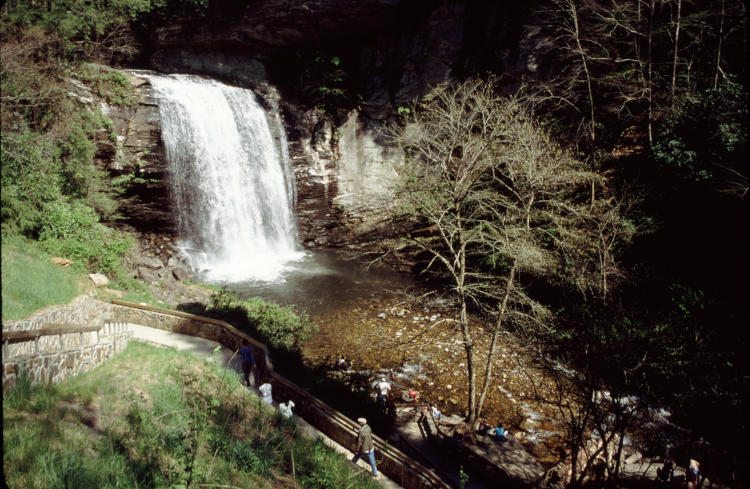
We open with a shot from 2005, of Looking Glass Falls in Brevard, in the top two of familiar waterfalls in North Carolina. But this one isn’t the ‘best’ that I got while there, because I certainly got a lot closer, and did longer exposures to make the water all blurred and cottony, and all that. Instead, this was to illustrate the public access areas, as well as showing what was produced by Fuji Provia slide film in those conditions – which is admittedly different from the following comparison shot. Normally I got much better color than this, so I don’t know if this was a bad batch, or older, or got a little too heated in my bag, or what, but it’s not impressive in any way. Though while we’re here, we’ll take a look at where the overlook is (the splash of blue helps you to realize how far down it goes,) because this was shot from the roadside; there’s no parking ‘lot’ for the area because there wasn’t the room or the topography for anything that size, but the road had been significantly widened to allow roadside parking well down from here, and it was often pretty close to capacity. You also can’t really tell from this shot, but access outside of the railed viewing area is easy, and getting down to water level (and even right underneath the falls) is trivial to accomplish, so perhaps a quarter of those visiting, myself included, got down for different perspectives.
Look down to the lower right, where a crisscross of small trees is silhouetted against brighter background: that’s a very large fallen trunk right there, extending well out over the shallow creek leading from the foot of the falls.
Now we go a little more recent.

This came from 2017, actually the day of the total solar eclipse, just not at all during the eclipse. We were traveling south to get into the path of totality, and since we were passing, we had to stop. Deep haze and a different time of day changed the lighting conditions, but you’ll note that there are four times as many people here now. No, wait, you won’t, because I purposefully got down well away from where they might intrude, and waited until the family playing on the rocks near the falls (about midframe) got out of view. The overlook is just a little outside of the frame to the left, and I’m shooting from the end of that fallen trunk that I mentioned above, still there twelve years later. Now chasing the fartsy thing, I closed down the aperture to ensure that I’d get a longer exposure, in this case 0.6 seconds – not terribly long, but easily enough to blur the very active water, while also not giving others too much time to get into the frame again.
This doesn’t really illustrate the difference in slide film and digital, because I’ve gotten much better results from Provia than this, nor the improvements that I’ve made over the years, because I had done better images than the first even on that same day. But what it does illustrate is the difference between a snapshot and a scenic landscape, one able to be made into a large print for your walls (like the meter-wide canvas right over my desk here at Walkabout Studios.) Slightly more effort to get a good perspective, a little selective framing, a little patience to allow people to get out of the frame, and just a wee bit of knowledge of how to make the water more interesting – that’s all. The viewer has no impression of the incessant chattering of tourists off to the left, interspersed with the squeals and cries of the kids, and no sight of the various people traipsing through the waters. It’s all a lie, is what I’m saying, but one of those good lies…
[It’s not all a lie, really: the smells that you might be imagining, the feel of the humidity and even the spray in the air, the tricky footing underneath – those were all present and accurate to the image. Just not the implied seclusion.]



















































